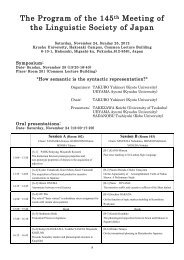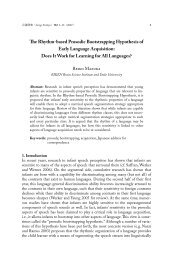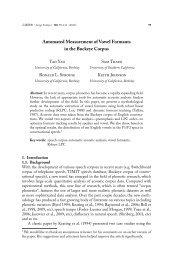第117åæ¥æ¬è§£åå¦ä¼ç·ä¼ã»å ¨å½å¦è¡éä¼ è¬æ¼ããã°ã©ã ã»æé²é PDF ...
第117åæ¥æ¬è§£åå¦ä¼ç·ä¼ã»å ¨å½å¦è¡éä¼ è¬æ¼ããã°ã©ã ã»æé²é PDF ...
第117åæ¥æ¬è§£åå¦ä¼ç·ä¼ã»å ¨å½å¦è¡éä¼ è¬æ¼ããã°ã©ã ã»æé²é PDF ...
You also want an ePaper? Increase the reach of your titles
YUMPU automatically turns print PDFs into web optimized ePapers that Google loves.
152<br />
117 <br />
P<br />
Inhibitory inputs of CCKpositive neurons to PVexpressing neurons<br />
in mouse neocortex<br />
1 1 1 1 2 <br />
1 1,3 1<br />
1<br />
2 <br />
3 CREST<br />
Neocortical GABAergic interneurons are roughly classified into three subgroups<br />
by chemical markers, parvalbumin PV, somatostatin SS and others such<br />
as vasoactive intestinal polypeptide VIP and cholecystokinin CCK. PV<br />
expressing neurons, fastspiking neurons, are a major component of GABAergic<br />
interneurons in neocortex. We generated transgenic mice expressing dendritic<br />
membranetargeted GFP selectively in PVexpressing neurons, and succeeded in<br />
visualizing somata and dendrites in a Golgi stainlike fashion.<br />
We previously investigated inhibitory inputs to PVexpressing neurons from PV,<br />
SS or VIPexpressing neurons, by combining immunofluorescence labeling of<br />
presynaptic and postsynaptic sites with antibodies to presynaptic markers and<br />
gephyrin, respectively. PV or SSpositive axon terminals made close contacts<br />
to the dendrite, whereas axon terminals of VIPexpressing neurons preferred the<br />
soma.<br />
In the present study, we visualize axon terminals of CCKexpressing neurons by<br />
immunofluorescence staining in the transgenic mice, observe the close appositions<br />
to PVexpressing neurons under confocal laserscanning microscope, and analyze<br />
the inputs quantitatively.<br />
P<br />
Elimination of somatic climbing fiber synapses proceeds with the<br />
differentiation of cerebellar interneurons<br />
<br />
<br />
In the developing cerebellum, the soma of individual Purkinje cells PCs is<br />
innervated by multiple climbing fibers CFs. Through their competition, only<br />
a single winner CF translocates to dendrites and the remaining somatic CF<br />
synapses are eliminated, leading to the establishment of CF monoinnervation.<br />
Concomitantly, basket cell fibers BFs begin to form inhibitory synapses on<br />
PC somata. Here, we examined anatomical relationship between declining CFs<br />
and developing inhibitory neurons at PC soma by light and electron microscopic<br />
analysis. In the first postnatal week of murine life, CFs innervated the entire<br />
somatic surface. Thereafter, BFs expanded their innervation from the apical<br />
side of PC somata downwards in synchrony with the reduction of somatic CF<br />
synapses. Furthermore, CF terminals frequently detached from the basal side of<br />
PC somata and often formed synapses on the somatodendritic domain of Lugaro<br />
cells LCs, a cerebellar interneuron lying just below the PC layer. These findings<br />
suggest that elimination of somatic CFs proceeds with the differentiation of<br />
cerebellar interneurons, such as BFs expelling somatic CF synapses and LCs<br />
accommodating perisomatic CF terminals.<br />
P<br />
Tectothalamic inhibitory neurons in the inferior colliculus receive<br />
converged axosomatic excitatory inputs from multiple sources<br />
<br />
<br />
Tectothalamic inhibitory TTI cells in the inferior colliculus IC are encircled<br />
by dense excitatory terminals positive for vesicular glutamate transporter 2<br />
VGLUT2. Four auditory brainstem nuclei including IC itself were identified<br />
as possible sources by examining mRNA expression of VGLUT1 and VGLUT2<br />
in ICprojecting cells. In this study, Sindbis/palGFP virus was injected in these<br />
nuclei to elucidate whether neurons in the nuclei make axosomatic contacts on<br />
TTI cells or not. Labeled neurons in all four nuclei made axosomatic contacts<br />
on large GABAergic neurons with dense axosomatic terminals, presumable TTI<br />
PTTI cells. Furthermore, a single axon made one to six contacts on a PTTI cell.<br />
In 3 cases, single IC excitatory cell was successfully labeled, and analyzed for<br />
spatial relationship between the labeled axon and PTTI cells. Single IC excitatory<br />
cell made axosomatic contacts on 1030 PTTI cells in the ipsilateral IC. Finally,<br />
double injection of Sindbis/palGFP and Sindbis/palmRFP viruses in 2 nuclei<br />
revealed convergence of inputs from 2 nuclei on a single PTTI cell. The results<br />
imply both divergence and convergence of auditory information on the cell bodies<br />
of TTI cells.<br />
P<br />
Axon terminals of the corticocollicular projection in the rat auditory<br />
system<br />
<br />
<br />
<br />
The corticocollicular projection was visualized by Sidbis virus and studied<br />
morphologically. The axons visualized with Golgi method in the inferior colliculus<br />
IC have been classified into three types and studied electronmicroscopically, A.<br />
J. Rocket and E. G. Jones, 1972,1973 with their origins mentioned prooflessly.<br />
We successfully visualized corticocollicular projection exclusively by infection<br />
of a recombinant Sindbis virus into cortical projection neurons in the auditory<br />
area. The Sindbis virus which expresses palmitoilationsiteadded GFP as the<br />
reporter gene is a kind gift from Dr. Kaneko in Kyotouniversity. The cortico<br />
collicular axon terminal images in the inferior colliculus was morphologically<br />
studied and compared with intrinsic axons from IC neuron which are stained in the<br />
same way. We further observed cortical projections into the nucleus of brachium<br />
of IC, external nucleus of IC, central nucleus of IC and deep layer of the superior<br />
colliculus. It should be noted that different types of termination exist in the above<br />
mentioned auditory brainstem.<br />
P<br />
Afferent projection to amygdaloid subnuclei and intrinsic connection<br />
of each subnuclei<br />
<br />
<br />
The amygdala is structurally diverse and comprised of several subnuclei. Extra<br />
and intraamygdala inputs into these subnuclei were extensively investigated by<br />
injection of CTb into various amygdaloid subnucleri, respectively. Ce received<br />
moderate to heavy inputs from almost all amygdaloid subnuclei, and from limbic<br />
cortex and hippocampus APir and AI, thalamus PV and MGM, hypothalamus<br />
VMH and midbrain PB. Me received moderate to heavy inputs from BM, Co,<br />
and from limbic cortex and hippocampus Pir, AHi and CA1, thalamus PV and<br />
hypothalamus VMH. BM received moderate inputs from Me, Co and BL, and<br />
from limbic cortex AI and thalamus PV. BL received moderate inputs from<br />
Me, La, BM, Co, and from limbic cortex and hippocampus LEnt, APir and CA1,<br />
thalamus PV and midbrain PB. La received moderate to heavy inputs from<br />
Me, Co, BM and BL, and from limbic cortex Ect and PRh, thalamus MGM<br />
and hypothalamus VMH. Co received light to heavy inputs from La, Me, and<br />
from limbic cortex and hippocampus AI, Pir and DEn and thalamus PV, PT and<br />
MGM. These subnucleispecific afferent projections are involved in emotional<br />
process in a different manner.<br />
P<br />
<br />
<br />
<br />
<br />
<br />
<br />
<br />
<br />
<br />
HeLa <br />
<br />
αtubulin Hec1CENPA







